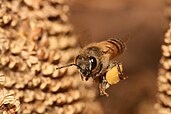Content deleted Content added
The Transhumanist (talk | contribs) Remove deletion discussion notice. See Wikipedia:Village pump (proposals)/RfC: Ending the system of portals using AWB |
Dreamy Jazz (talk | contribs) No edit summary |
||
| Line 1: | Line 1: | ||
<!-- This portal was created using subst:box portal skeleton| topic=Topic| --> |
<!-- This portal was created using subst:box portal skeleton| topic=Topic| --> |
||
| ⚫ | |||
{| width="100%" cellpadding="5" cellspacing="10" style="background:#99FF66; border-style:solid; border-width:1px; border-color:#;#99FF66" |
{| width="100%" cellpadding="5" cellspacing="10" style="background:#99FF66; border-style:solid; border-width:1px; border-color:#;#99FF66" |
||
| width="55%" style="vertical-align:top;padding: 0; margin:0;" | |
| width="55%" style="vertical-align:top;padding: 0; margin:0;" | |
||
| ⚫ | |||
<div style="float:right; width:100%"> |
<div style="float:right; width:100%"> |
||
| Line 8: | Line 8: | ||
{{/box-header|'''<big>Agriculture and agronomy portal</big>'''|Portal:Agriculture and agronomy/Intro|}} |
{{/box-header|'''<big>Agriculture and agronomy portal</big>'''|Portal:Agriculture and agronomy/Intro|}} |
||
{{Portal:Agriculture and agronomy/Intro}} |
{{Portal:Agriculture and agronomy/Intro}} |
||
{{/box-footer|}} |
{{/box-footer|'''[[Agriculture|More about Agriculture...]]'''}} |
||
<div style="text-align:center; margin:0.25em 0 0.75em 0;">{{purge|'''View new selections below''' (purge)}}</div> |
<div style="text-align:center; margin:0.25em 0 0.75em 0;">{{purge|'''View new selections below''' (purge)}}</div> |
||
Revision as of 21:05, 19 May 2018
Selected article
A honey bee (also spelled honeybee) is a eusocial flying insect within the genus Apis of the bee clade, all native to mainland Afro-Eurasia. After bees spread naturally throughout Africa and Eurasia, humans became responsible for the current cosmopolitan distribution of honey bees, introducing multiple subspecies into South America (early 16th century), North America (early 17th century), and Australia (early 19th century).
Honey bees are known for their construction of perennial colonial nests from wax, the large size of their colonies, and surplus production and storage of honey, distinguishing their hives as a prized foraging target of many animals, including honey badgers, bears and human hunter-gatherers. Only 8 surviving species of honey bee are recognized, with a total of 43 subspecies, though historically 7 to 11 species are recognized. Honey bees represent only a small fraction of the roughly 20,000 known species of bees. (Full article...) (Full article...) Selected picture Credit: www.volganet.ru Sustainable agricultureDid you know...Agriculture and agronomy journalsWikiProjectsTopicsThings you can doRelated portalsCategoriesRelated articlesAssociated WikimediaReferences
|
